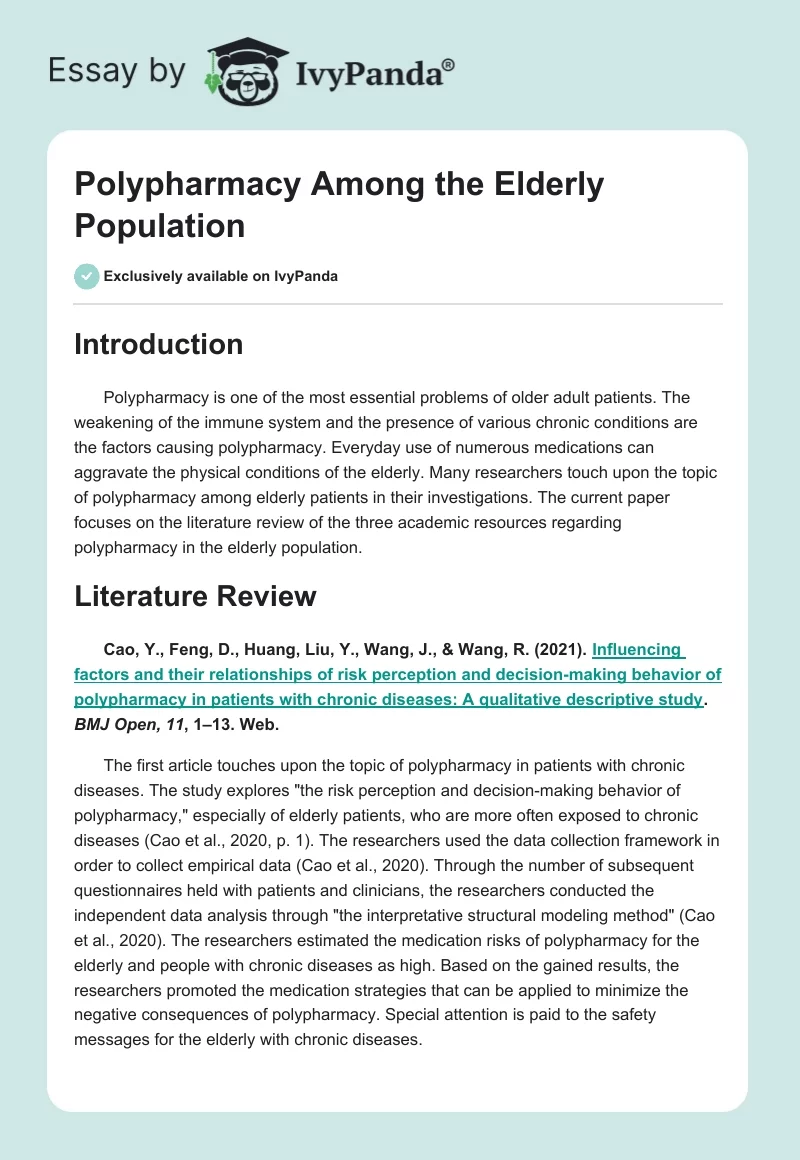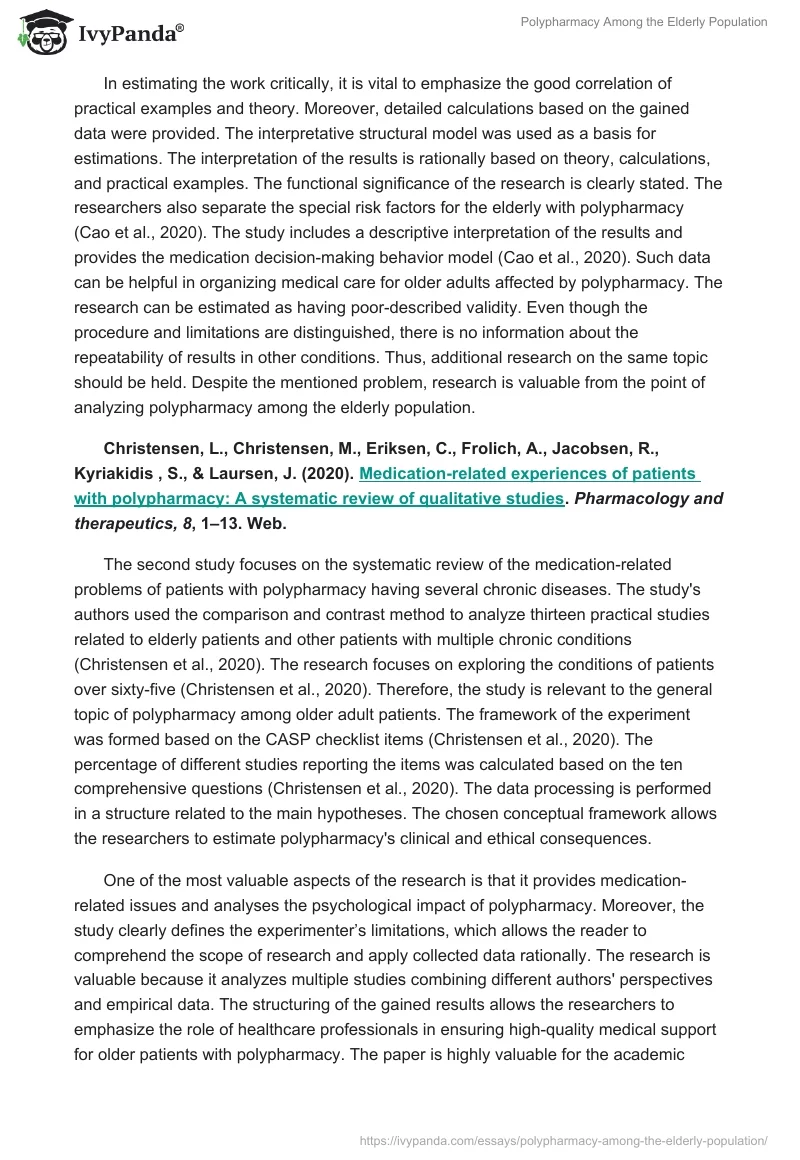Introduction
Polypharmacy is one of the most essential problems of older adult patients. The weakening of the immune system and the presence of various chronic conditions are the factors causing polypharmacy. Everyday use of numerous medications can aggravate the physical conditions of the elderly. Many researchers touch upon the topic of polypharmacy among elderly patients in their investigations. The current paper focuses on the literature review of the three academic resources regarding polypharmacy in the elderly population.
Annotated Bibliography
Cao, Y., Feng, D., Huang, Liu, Y., Wang, J., & Wang, R. (2021). Influencing factors and their relationships of risk perception and decision-making behavior of polypharmacy in patients with chronic diseases: A qualitative descriptive study. BMJ Open, 11, 1–13. Web.
The first article touches upon the topic of polypharmacy in patients with chronic diseases. The study explores “the risk perception and decision-making behavior of polypharmacy,” especially of elderly patients, who are more often exposed to chronic diseases (Cao et al., 2020, p. 1). The researchers used the data collection framework in order to collect empirical data (Cao et al., 2020). Through the number of subsequent questionnaires held with patients and clinicians, the researchers conducted the independent data analysis through “the interpretative structural modeling method” (Cao et al., 2020). The researchers estimated the medication risks of polypharmacy for the elderly and people with chronic diseases as high. Based on the gained results, the researchers promoted the medication strategies that can be applied to minimize the negative consequences of polypharmacy. Special attention is paid to the safety messages for the elderly with chronic diseases.
In estimating the work critically, it is vital to emphasize the good correlation of practical examples and theory. Moreover, detailed calculations based on the gained data were provided. The interpretative structural model was used as a basis for estimations. The interpretation of the results is rationally based on theory, calculations, and practical examples. The functional significance of the research is clearly stated. The researchers also separate the special risk factors for the elderly with polypharmacy (Cao et al., 2020). The study includes a descriptive interpretation of the results and provides the medication decision-making behavior model (Cao et al., 2020). Such data can be helpful in organizing medical care for older adults affected by polypharmacy. The research can be estimated as having poor-described validity. Even though the procedure and limitations are distinguished, there is no information about the repeatability of results in other conditions. Thus, additional research on the same topic should be held. Despite the mentioned problem, research is valuable from the point of analyzing polypharmacy among the elderly population.
Christensen, L., Christensen, M., Eriksen, C., Frolich, A., Jacobsen, R., Kyriakidis , S., & Laursen, J. (2020). Medication-related experiences of patients with polypharmacy: A systematic review of qualitative studies. Pharmacology and therapeutics, 8, 1–13. Web.
The second study focuses on the systematic review of the medication-related problems of patients with polypharmacy having several chronic diseases. The study’s authors used the comparison and contrast method to analyze thirteen practical studies related to elderly patients and other patients with multiple chronic conditions (Christensen et al., 2020). The research focuses on exploring the conditions of patients over sixty-five (Christensen et al., 2020). Therefore, the study is relevant to the general topic of polypharmacy among older adult patients. The framework of the experiment was formed based on the CASP checklist items (Christensen et al., 2020). The percentage of different studies reporting the items was calculated based on the ten comprehensive questions (Christensen et al., 2020). The data processing is performed in a structure related to the main hypotheses. The chosen conceptual framework allows the researchers to estimate polypharmacy’s clinical and ethical consequences.
One of the most valuable aspects of the research is that it provides medication-related issues and analyses the psychological impact of polypharmacy. Moreover, the study clearly defines the experimenter’s limitations, which allows the reader to comprehend the scope of research and apply collected data rationally. The research is valuable because it analyzes multiple studies combining different authors’ perspectives and empirical data. The structuring of the gained results allows the researchers to emphasize the role of healthcare professionals in ensuring high-quality medical support for older patients with polypharmacy. The paper is highly valuable for the academic medicine field as far as it provides the generalization and structuring of the practical research.
Dolovich, L., Gerard, N., Kontio, T., Laeer, C., Lui, E., Mathers, A., & Patel, P. (2020). A descriptive quantitative analysis on the extent of polypharmacy in recipients of Ontario primary care team pharmacist-led medication reviews. Pharmacy, 8(3), 103–108. Web.
The third resource analyzes the problems related to medication prescription in elderly patients with several chronic diseases. The researcher proposes outstanding data collection methods (Dolovich et al., 2020). One of the most prominent aspects of the research is that the actual data from different hospitals were extracted through the database called REDCap (Dolovich et al., 2020). Such an approach allowed to avoid potential biases because the direct connection with the patients was unnecessary. The results were presented in numerical and descriptive forms. The chosen framework can be called case-leveling due to the level model of results representation. The study’s theoretical framework is centered on the pharmacist’s check and medication reviews of the combined prescription of different medications. The researchers analyze the practical percentage of the negative consequences of combined prescription with and without pharmacists’ primary care checks through this framework.
The study provides detailed statistics and calculations regarding the percentage of aging patients diagnosed with polypharmacy (Dolovich et al., 2020). Using the practical data, the researchers emphasize the role of safe and efficient pharmacists’ support. The chosen framework allowed us not only to statistically analyze the occurrence of polypharmacy in older patients but also to estimate the negative consequences of the wrong medication combinations. The detailed analysis of the practical data contributes to a comprehensive understanding of polypharmacy-related problems in older adult patients.
The critical estimation of the work shows that it is practically valuable for the treatment of elderly patients with several chronic diseases and polypharmacy. The researchers emphasize the increased risk of adverse condition occurrence for such patients and state the possible methods to alleviate negative consequences. One of the most vital drawbacks of the research is its population limitations. Territorial and time factors significantly limit the data collection. Therefore, the results cannot be generalized for all elderly patients with polypharmacy. Moreover, the researchers’ improvement suggestions are theoretical and have no practical support. Therefore, the results should be more detailed, checked, and realized within the practical experiments. However, the study is of academic significance due to providing vital for future research statistics, unique level classification, and theoretical assumptions improving the medication prescription for elderly patients with polypharmacy.
Conclusion
Various authors examine the topic of polypharmacy in elderly patients. Different types of research are applied in exploring this topic. Each of the analyzed resources contributes to the development of the treatment outcomes and increases the life expectancy of the mentioned patient population. The problem of polypharmacy cannot be avoided in elderly patients. However, the detailed exploration of this issue may contribute to alleviating the adverse conditions for the elderly.


